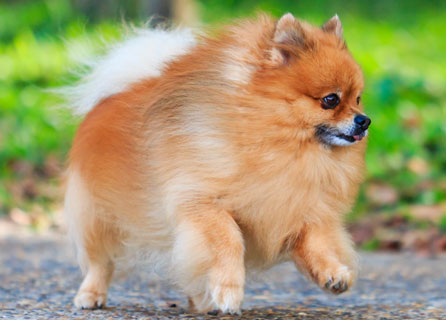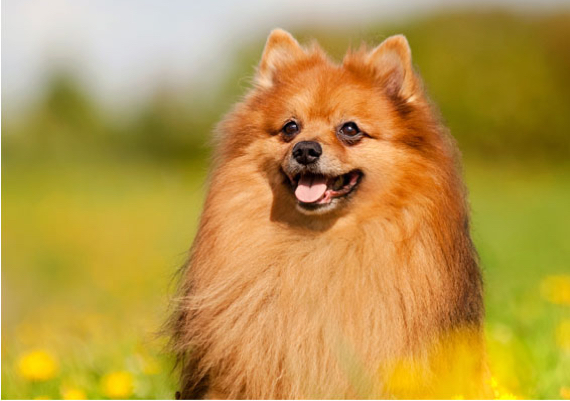
Pomeranian breed guide
Friendly, inquisitive and playful, the fox-faced Pomeranian is the perfect companion and a fantastic watchdog. Discover this extroverted little dog, and get tips on a range of topics from exercise, grooming and behaviour, to what you can do to keep your dog healthy and happy.
Breed information and advice
The lively and intelligent Pomeranian is part of the toy dog group and the smallest of the spitz breeds. Descended from sled dogs, they may be small but they are a surprising bundle of energy, so make sure to give them plenty of attention. Here's more you should know:
- The Pomeranian has a bold 'can-do' attitude and is quite feisty, so it’s wise to train your dog early on to show them who’s in charge.The Pomeranian has a bold 'can-do' attitude and is quite feisty, so it’s wise to train your dog early on to show them who’s in charge.
- Their thick double coat requires frequent brushing, and their eyes and ears should be cleaned regularly.Their thick double coat requires frequent brushing, and their eyes and ears should be cleaned regularly.
- They'll typically weigh from 2kg to 3kg when fully grown.They'll typically weigh from 2kg to 3kg when fully grown.
- A healthy Pomeranian can live between 12 and 16 years.A healthy Pomeranian can live between 12 and 16 years.
Typical size of a Pomeranian: Small: 18cm-30cm

Recommended exercise and nutrition
Pomeranians are naturally active and curious, so will need at least half an hour of exercise a day, or to be taken for several shorter walks. As such a peppy breed, it’s important to introduce training early on in your dog’s life so that you give them the opportunity to socialise with other people and animals and teach them the quiet command from the start.
Pomeranians can be fussy eaters, but firm and gentle training when your dog is a puppy should help. Feeding quantities will depend on your dog’s size and age and always read the directions on the packet.
Half an hour of exercise per day
An energetic, alert little dog that enjoys going for walks and exploring the house, as well as being taught tricks and agility training.

Common health problems and illnesses
Pomeranians are generally healthy dogs but they’ll need regular check-ups and vaccinations to stay in good shape. There are some conditions that this breed may be more prone to, and it’s worth being aware of the main symptoms, so you know what to watch out for.
A common injury affecting this breed is a dislocated kneecap, also known as a luxating patella. This is a condition that they’ll have been born with, and signs to look out for include occasional skipping or hind-leg lameness. Simple surgery is usually the best way to treat this condition, but your vet can advise on the best course of action.
Try to take notice of the sounds your Pomeranian makes. A harsh cough could be a sign of a collapsed windpipe, which can be caused when small dogs pull too hard against their collar during walks. You can avoid this condition by using a body harness rather than a collar, or by training your dog to walk alongside you.
Cushing’s disease is a common hormonal disorder that affects how the body regulates itself and may alter a Pomeranian’s behaviour and appearance. If you see a marked increase in your dog’s thirst and how much he goes to the toilet, or notice any signs of weakness or patchy hair loss, then contact your vet who will advise on the most effective treatment.
Alopecia X is a total or partial loss of fur loss. The exposed skin becomes hyperpigmented or 'black'. The hair follicles on the body and tail quit actively growing and get stuck in a resting phase. Then, when the hair is naturally shed, it is no longer replaced. Please speak to your vet for more information.
Pomeranians are prone to a common condition, called hypothyroidism, where the body doesn’t make enough thyroid hormone. Signs can include dry skin and coat, hair loss, susceptibility to other skin diseases, weight gain, lethargy, mental dullness, sleeping excessively, fearfulness, aggression, or other behavioural changes. Speak to your vet for information on treatment.
Find out about insurance for your Pomeranian
Learn how pet insurance works and what kind of cover you might need for your dog.
Grooming advice
Regular weekly grooming, with an occasional bath when necessary, is enough to keep your Pomeranian proudly looking their best. It can also be a great bonding experience to bring you closer together.
This breed has a thick double coat which needs to be brushed frequently to remove the dead hair and dander that can give people an allergic reaction. Your dog also has tough, fast-growing nails that should be clipped or trimmed regularly to prevent scratching, splitting or cracking.
Common in most small breeds, Pomeranians may experience teeth and gum problems. Try to brush their teeth ideally on a daily basis, and give them high-quality dry dog food to encourage good oral health. It’s also worth taking the time to check their eyes and ears for any build-up of dirt and debris, as this can lead to infections.
Fun and interesting facts
- A Pom called Boo, claimed to be the ‘World’s Cutest Dog’, was a YouTube and Facebook sensation in the early 2010s.A Pom called Boo, claimed to be the ‘World’s Cutest Dog’, was a YouTube and Facebook sensation in the early 2010s.
- They are one of the most diversely coloured dogs in the world. The American Kennel Club lists 18 different colours and nine different markings for this single breed.They are one of the most diversely coloured dogs in the world. The American Kennel Club lists 18 different colours and nine different markings for this single breed.
- Queen Victoria and President Theodore Roosevelt were both admirers of Pomeranians, contributing to their popularity.Queen Victoria and President Theodore Roosevelt were both admirers of Pomeranians, contributing to their popularity.
- One of the breed’s first recorded fans was Michelangelo, who is believed to have had one by his side when he painted the Sistine Chapel.One of the breed’s first recorded fans was Michelangelo, who is believed to have had one by his side when he painted the Sistine Chapel.
- Pomeranians are the smallest of the Arctic spitz breeds, which include Akitas, Huskies and Samoyeds.Pomeranians are the smallest of the Arctic spitz breeds, which include Akitas, Huskies and Samoyeds.
Important information
The content on this page aims to offer an informative introduction to pet breeds, but does not constitute expert veterinary advice. If your dog or cat falls ill or has an injury, contact your vet immediately.
All facts and figures were correct at date of publication and were compiled using a range of sources.
Discover more breeds
Browse our other cat and dog guides to learn about some of the UK’s most popular breeds.